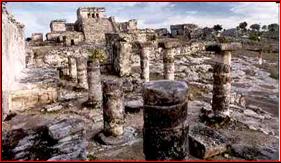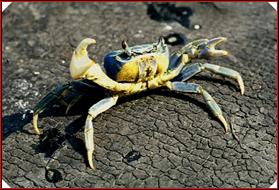| Don't forget
to visit
Moustrails, the official blog of Wild Monthly! |
Feeling Crabby?
 areful
planning went into our honeymoon in Mexico. My husband and I wanted
spend time visiting Mayan ruins rather than partying in nightclubs in
Cancun. We visited
Coba, which boasts the tallest Mayan pyramid in the Yucatan, Nohoch Mul.
We visited Tulum, the city by the sea, which boasts the “descending god”
images that have delighted those interested in extraterrestrials and
so-called “ancient astronauts.” We also visited a small area of ruins
near Cancun called El Rey, seen here in a photo I took in 1988.
areful
planning went into our honeymoon in Mexico. My husband and I wanted
spend time visiting Mayan ruins rather than partying in nightclubs in
Cancun. We visited
Coba, which boasts the tallest Mayan pyramid in the Yucatan, Nohoch Mul.
We visited Tulum, the city by the sea, which boasts the “descending god”
images that have delighted those interested in extraterrestrials and
so-called “ancient astronauts.” We also visited a small area of ruins
near Cancun called El Rey, seen here in a photo I took in 1988.

El Rey is less glamorous than the other sites on the
Yucatan peninsula. It does not have a terribly tall pyramid or
descending god images. It does have columns, and steps, and a road of
sorts. Determined to get away from the crowded tourist shops, we
asked a cab driver to take us to El Rey. We did this by pointing to
the place on our map called “archeological excavation” and hoping for the
best. Neither of us spoke Spanish, so we had to trust the driver to
take us to the right place. We left the hotel, drove along the main
road, and suddenly turned onto a dirt road that lead (as it appeared to us
city dwellers) into the jungle. I must admit that I was feeling a bit
nervous at this time, but we soon pulled up to a small clearing where two
men sat playing checkers, while a younger man stood up against a tree
watching the game. The cab driver said a few things we did not
understand to the man under the tree, and told us to get out, but he would
wait here, as no cabs were likely to come by. The young man (it
turned out that he was a university student studying Mayan culture) who had
been standing by the tree spoke in halting, though unclear English, but we
go the idea—he was a guide, his name was Juan, and for a price he would
give us the tour of El Rey. He and my husband negotiated a price, and
we set off to explore the ruins in a one hour tour with Juan. As we
ended the tour, our guide told us he could not answer any questions because
he had already told us all he knew about the site, but he asked us a
question:
“Are you familiar with cab?”
We looked at each other and said, “Yes.”
“I will catch a cab!” And off he went
past the edge of the ruins.
 We
stood puzzled for a moment until our faithful guide brought a huge blue
land crab out from his dwelling hole in the ruins. The crab,
held with its claws well apart, was about a foot wide, with medium eye
stalks and a lovely blue and yellow color! I had seen the crabs
crossing the road sometimes, but I have been unable to see one close up.
Here was my opportunity, thanks to Juan.
We
stood puzzled for a moment until our faithful guide brought a huge blue
land crab out from his dwelling hole in the ruins. The crab,
held with its claws well apart, was about a foot wide, with medium eye
stalks and a lovely blue and yellow color! I had seen the crabs
crossing the road sometimes, but I have been unable to see one close up.
Here was my opportunity, thanks to Juan.
Prior to studying marine biology in college, my
experience with crabs was limited to those I ate, and the tiny hermit crabs
that live in the shallows of Massachusetts Bay. I was delighted to
find the book
Pagoo on the shelf in the invertebrate zoology lab at college, and even
more delighted when my professor told us that Pagoo was the reason he
became a biologist.
Hermit crabs and other crabs all share common
features. Crabs have ten legs, including their threatening claws, and
so are called decapods. Crabs don’t bite (us) because their
mouths are too small, but many common crabs can pinch hard enough to draw
blood. Some crabs are “swimming crabs” and some are walking crabs.
All crabs must spend some of their life cycle in the water, so any land
crab is truly amphibious.
Female crabs keep their eggs under their tails.
Tails? Crabs have tails? Yes they do! Unlike their
lobster cousins, the tail of a crab (except the hermit crab) is folded
neatly under the abdomen. You can tell a male crab from a female crab
by the width of the tail. The female’s is wider so she can keep her
eggs (<--click for amazing photos of gravid female crabs!) under her
tail, which is otherwise kept close to her body.
Baby crabs are typically planktonic (they float
in the ocean mostly at the mercy of the currents). They are called
zoea at hatching, megalops after molting (or after several
molts, depending on the species), and “first crab” when the young megalops
folds its tail under the body during a molt and assumes the typical adult
crab form. While the stages of development are the same for all
crabs, the hermit crab keeps its tail loose for twining into the empty
shell of a snail.
Speaking of molting, that’s something that crabs and
other crustaceans do, but clams and snails don’t. Like your bones,
the shell of a snail grows with it. A crab must shed its shell
to grow bigger. When a hermit crab grows, it finds the shell of a
snail to protect the soft part of its body. The snail has not
abandoned the shell...it has died and rotted out of the shell, or was
pulled out and eaten. The soft shell (freshly molted) stage of any
crab’s life is a dangerous one, as we can tell if we have eaten
soft-shelled crab. Without the hard outer shell, a crab is easily
eaten, not only by humans, but by other predators. Most crabs go into
hiding when the new, bigger shell is forming and hardening.
Hermit crabs also molt like other crabs, even though
they also live in the hard shells of snails. Molting and moving to a
new shell are different activities in the life of the hermit crab, but may
take place at the same time. The hard body of a hermit crab is very
different from the soft body of the snail. You can compare the two
the next time you visit an aquarium or pet store.
Land hermit crabs make easy-care pets. They have
been known to live for up to 18 years in captivity, and very fun to watch,
especially at feeding time. As they have become more popular as pets,
hermit crabs are often found for sale in mall kiosks with an array of
painted shells available that rival nature in variety, if not always in
beauty. During one recent visit to the mall, I saw a hermit crab
sporting a BMW logo on its shell! The “fancy” shells (painted by
hand!!) are a bit pricier than
natural shells. Our friend Lara recommends watching crabs
carefully when they change shells. She kept several, but was curious
when one disappeared without a trace. It seems the missing crab had
his home taken over by another crab while he was still in it. Unable
to feed, the inner crab died.
If you live near the sea, you might want to set up a
small salt water tank and catch your own hermit crabs. These are
likely to be small crabs, like Pagoo, but they cost less! Setting up
a salt tank using local water is very easy. Set it up according to
directions for a typical tropical fish tank, but fill it with water from
your local sea shore—just remember to add fresh water, not more salt
water, when the water level gets low, to keep the salinity constant.
When water evaporates from the tank, the salt remains behind, so adding
salt water will kill your tank creatures in a few days. Hermit crabs
will eat just about anything you add tot he tank. I once saw some
hermits go crazy over some frog eggs that were dropped into their tank.
Keep a bit of sea weed and maybe a local minnow or two. You might
capture a specimen and observe it for a day or two, and then release it.
Try to find a specimen with
snail fur, a kind of animal that lives not on snails, but on the
shells of hermit crabs.
Whether you choose to keep crabs, eat them, or just
study them, you’ll find the variety of crabs astonishing. On
Christmas Island, the annual crab migration is aided by tunnels under roads
(see
Red Crab Brochure). Some crabs camouflage themselves with seaweed
and sponges. The smallest crab, the pea crab, lives inside some shell
fish, and is a crunchy surprise to those who enjoy eating steamed mussels!
The largest crab is the Japanese spider crab, and may be 12 feet long from
claw tip to tip. Land hermit crabs tend to be bigger than many
aquatic cousins. There are many books on crabs and links to enjoy.
Here are a few to get you started:
Picture of Hermit Crab Species (wonderful site)
Hermit Crab anatomy
Pacific coast (US) crab varieties
Alaskan
Crab Recipes
Maryland Crab Recipes
Australian Crab
Recipes
Back to Wild Monthly
Back to Mousetrails
Back to MacBeth's
Opinion
Blue Land Crab photo courtesy the
State of Florida Marine Fisheries
 areful
planning went into our honeymoon in Mexico. My husband and I wanted
spend time visiting Mayan ruins rather than partying in nightclubs in
Cancun. We visited
Coba, which boasts the tallest Mayan pyramid in the Yucatan, Nohoch Mul.
We visited Tulum, the city by the sea, which boasts the “descending god”
images that have delighted those interested in extraterrestrials and
so-called “ancient astronauts.” We also visited a small area of ruins
near Cancun called El Rey, seen here in a photo I took in 1988.
areful
planning went into our honeymoon in Mexico. My husband and I wanted
spend time visiting Mayan ruins rather than partying in nightclubs in
Cancun. We visited
Coba, which boasts the tallest Mayan pyramid in the Yucatan, Nohoch Mul.
We visited Tulum, the city by the sea, which boasts the “descending god”
images that have delighted those interested in extraterrestrials and
so-called “ancient astronauts.” We also visited a small area of ruins
near Cancun called El Rey, seen here in a photo I took in 1988.

 We
stood puzzled for a moment until our faithful guide brought a huge blue
land crab out from his dwelling hole in the ruins. The crab,
held with its claws well apart, was about a foot wide, with medium eye
stalks and a lovely blue and yellow color! I had seen the crabs
crossing the road sometimes, but I have been unable to see one close up.
Here was my opportunity, thanks to Juan.
We
stood puzzled for a moment until our faithful guide brought a huge blue
land crab out from his dwelling hole in the ruins. The crab,
held with its claws well apart, was about a foot wide, with medium eye
stalks and a lovely blue and yellow color! I had seen the crabs
crossing the road sometimes, but I have been unable to see one close up.
Here was my opportunity, thanks to Juan.